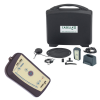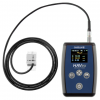Casella CEL 960 Human Vibration Monitor
- Measures and records X, Y and Z axis vibration levels, RMS and Peak
- Calculates and stores overall and time history data of vector sum, daily exposure A(8) and VDV
- Vibration input signal and 1/3 octave spectrum recording
- Presence detector and warning light (WB)
- Up to 20-hour run time with Lithium-Ion rechargeable battery
- Wireless remote control software: dB96
- Processing software: dB98
Exposure to high levels of vibration can cause risk of injury in the workplace. Many regulatory compliance agencies have promulgated recommended or mandated exposure limtis for both Hand-arm and Whole-body Vibration. For example, ACGIH has limits defined in its TLV/BEI handbook. Recently, the ANSI S 2.70 standard on Hand-arm Vibration was amended to reflect expsoure limits recommended by other standards in use such as ISO 5349. European Directive 2002/44/EC proscribes minimum safety and health recommendations relative to workers' exposure to risks from vibration exposure. This directive defines and regulates worker exposure limits including "daily exposure limit values" (DELV) and "daily exposure action values" (DEAV). It also articulates employers' obligations with regard to determining and assessing risks, measures to be taken to reduce or avoid exposure and what information must be provided including training for workers.
The EU action level and permissible expsoure limit values for daily (8hr) vibration have been set to:
- Exposure limit value: 5 m/s² for the Hand-Arm domain and 1.15 m/s² for the Whole-Body domain
- Exposure action value: 2.5 m/s² for the Hand-Arm domain and 0.5 m/s² for the Whole-Body domain
Human vibration includes the measurement of whole-body (WBV) vibration to study the vibration for seated workers on heavy equipment or transport vehicles. It also includes the measurement of hand-arm vibration (HAV) for those workers who use hand held power tools such as chipping hammers or grinders. Prolonged exposure to high levels of vibration from hand held tools can lead to Hand-arm Vibration Syndrome (HAVS) or Vibration White Finger (VWF) disease (Reynaud's Syndrome of Occupational Origin) where the fingertips lose sensation (neuropathy) and blood flow is altered which may eventually spread to the whole finger and could ultimately result in amputation if exposure is not minimized or sufficiently reduced.
The system hardware consists of an accelerometer (HA and/or WB) with connecting cable plus the analyzer which is housed in a very compact, rugged and lightweight case. A charging base is provided.
| Specification | Triaxial Hand-Arm Accelerometer | Triaxial Whole Body Seatpad | Monoaxial Accelerometer for SEAT (option) |
|---|---|---|---|
| Sensitivty | 10 mV/g | 10 mV/g | 10 mV/g |
| Dynamic Range | 500 g | 18 g | 500 g |
| Bandwidth | From 1 to 12,000 Hz (± 1dB) | From 0 to 2,000 Hz (- 3 dB) | From 0.1 to 1,000 Hz |
| Resonance Frequency | > 36 kHz | 5.5 kHz | > 28 kHz |
| Weight | 13 g | 270 g | 18 g |
| Temperature Range | -40°C / +125°C (-40°F / +257°F) | -20°C / +70°C (-4°F / +158°F) | -50°C / +125°C (-58°F / +275°F) |
| Material/Characteristics | Titanium | Seatpad with presence detector | Stainless steel |
| Accessories | Hand-arm Adapters for direct mount, steering wheel / handlebar, T-bar | Removable retractable reel cable | Floor mounting using an isolated magnetic base |

